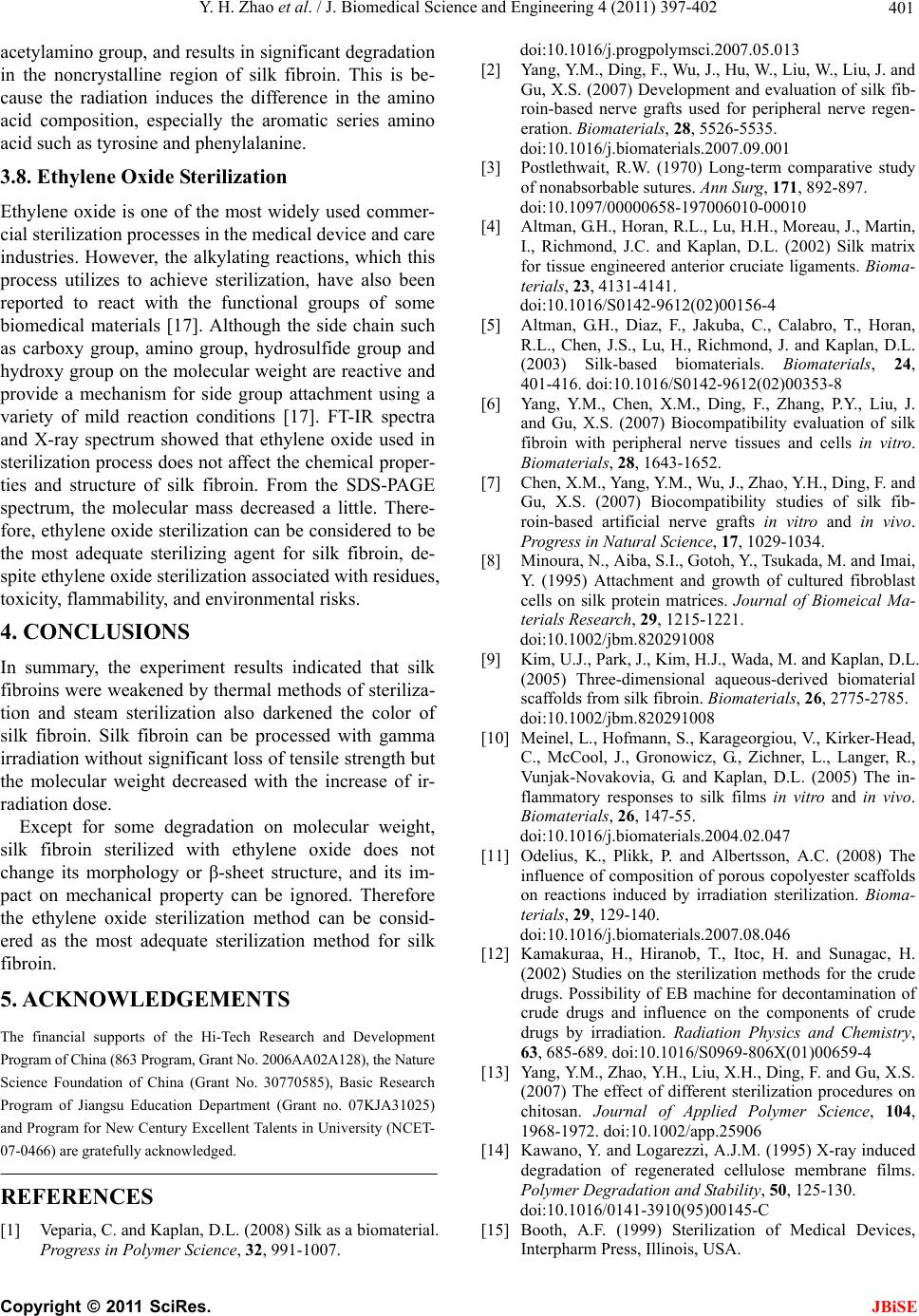
Y. H. Zhao et al. / J. Biomedical Science and Engineering 4 (2011) 397-402 401
acetylamino group, and results in significant degradation
in the noncrystalline region of silk fibroin. This is be-
cause the radiation induces the difference in the amino
acid composition, especially the aromatic series amino
acid such as tyrosine and phenylalanine.
3.8. Ethylene Oxide Sterilization
Ethylene oxide is one of the most widely used commer-
cial sterilization processes in the medical device and care
industries. However, the alkylating reactions, which this
process utilizes to achieve sterilization, have also been
reported to react with the functional groups of some
biomedical materials [17]. Although the side chain such
as carboxy group, amino group, hydrosulfide group and
hydroxy group on the molecular weight are reactive and
provide a mechanism for side group attachment using a
variety of mild reaction conditions [17]. FT-IR spectra
and X-ray spectrum showed that ethylene oxide used in
sterilization process does not affect the chemical proper-
ties and structure of silk fibroin. From the SDS-PAGE
spectrum, the molecular mass decreased a little. There-
fore, ethylene oxide sterilization can be considered to be
the most adequate sterilizing agent for silk fibroin, de-
spite ethylene oxide sterilization associated with residues,
toxicity, flammability, and environmental risks.
4. CONCLUSIONS
In summary, the experiment results indicated that silk
fibroins were weakened by thermal methods of steriliza-
tion and steam sterilization also darkened the color of
silk fibroin. Silk fibroin can be processed with gamma
irradiation without significant loss of tensile strength but
the molecular weight decreased with the increase of ir-
radiation dose.
Except for some degradation on molecular weight,
silk fibroin sterilized with ethylene oxide does not
change its morphology or β-sheet structure, and its im-
pact on mechanical property can be ignored. Therefore
the ethylene oxide sterilization method can be consid-
ered as the most adequate sterilization method for silk
fibroin.
5. ACKNOWLEDGEMENTS
The financial supports of the Hi-Tech Research and Development
Program of China (863 Program, Grant No. 2006AA02A128), the Nature
Science Foundation of China (Grant No. 30770585), Basic Research
Program of Jiangsu Education Department (Grant no. 07KJA31025)
and Program for New Century Excellent Talents in University (NCET-
07-0466) are gratefully acknowledged.
REFERENCES
[1] Veparia, C. and Kaplan, D.L. (2008) Silk as a biomaterial.
Progress in Polymer Science, 32, 991-1007.
doi:10.1016/j.progpolymsci.2007.05.013
[2] Yang, Y.M., Ding, F., Wu, J., Hu, W., Liu, W., Liu, J. and
Gu, X.S. (2007) Development and evaluation of silk fib-
roin-based nerve grafts used for peripheral nerve regen-
eration. Biomaterials, 28, 5526-5535.
doi:10.1016/j.biomaterials.2007.09.001
[3] Postlethwait, R.W. (1970) Long-term comparative study
of nonabsorbable sutures. Ann Surg, 171, 892-897.
doi:10.1097/00000658-197006010-00010
[4] Altman, G.H., Horan, R.L., Lu, H.H., Moreau, J., Martin,
I., Richmond, J.C. and Kaplan, D.L. (2002) Silk matrix
for tissue engineered anterior cruciate ligaments. Bioma-
terials, 23, 4131-4141.
doi:10.1016/S0142-9612(02)00156-4
[5] Altman, G
.H., Diaz, F., Jakuba, C., Calabro, T., Horan,
R.L., Chen, J.S., Lu, H., Richmond, J. and Kaplan, D.L.
(2003) Silk-based biomaterials. Biomaterials, 24,
401-416. doi:10.1016/S0142-9612(02)00353-8
[6] Yang, Y.M., Chen, X.M., Ding, F., Zhang, P.Y., Liu, J.
and Gu, X.S. (2007) Biocompatibility evaluation of silk
fibroin with peripheral nerve tissues and cells in vitro.
Biomaterials, 28, 1643-1652.
[7] Chen, X.M., Yang, Y.M., Wu, J., Zhao, Y.H., Ding, F. and
Gu, X.S. (2007) Biocompatibility studies of silk fib-
roin-based artificial nerve grafts in vitro and in vivo.
Progress in Natural Science, 17, 1029-1034.
[8] Minoura, N., Aiba, S.I., Gotoh, Y., Tsukada, M. and Imai,
Y. (1995) Attachment and growth of cultured fibroblast
cells on silk protein matrices. Journal of Biomeical Ma-
terials Research, 29, 1215-1221.
doi:10.1002/jbm.820291008
[9] Kim, U.J., Park, J., Kim, H.J., Wada, M. and Kaplan, D.L.
(2005) Three-dimensional aqueous-derived biomaterial
scaffolds from silk fibroin. Biomaterials, 26, 2775-2785.
doi:10.1002/jbm.820291008
[10] Meinel, L., Hofmann, S., Karageorgiou, V., Kirker-Head,
C., McCool, J., Gronowicz, G., Zichner, L., Langer, R.,
Vunjak-Novakovia, G. and Kaplan, D.L. (2005) The in-
flammatory responses to silk films in vitro and in vivo.
Biomaterials, 26, 147-55.
doi:10.1016/j.biomaterials.2004.02.047
[11] Odelius, K., Plikk, P. and Albertsson, A.C. (2008) The
influence of composition of porous copolyester scaffolds
on reactions induced by irradiation sterilization. Bioma-
terials, 29, 129-140.
doi:10.1016/j.biomaterials.2007.08.046
[12] Kamakuraa, H., Hiranob, T., Itoc, H. and Sunagac, H.
(2002) Studies on the sterilization methods for the crude
drugs. Possibility of EB machine for decontamination of
crude drugs and influence on the components of crude
drugs by irradiation. Radiation Physics and Chemistry,
63, 685-689. doi:10.1016/S0969-806X(01)00659-4
[13] Yang, Y.M., Zhao, Y.H., Liu, X.H., Ding, F. and Gu, X.S.
(2007) The effect of different sterilization procedures on
chitosan. Journal of Applied Polymer Science, 104,
1968-1972. doi:10.1002/app.25906
[14] Kawano, Y. and Logarezzi, A.J.M. (1995) X-ray induced
degradation of regenerated cellulose membrane films.
Polymer Degradation and Stability, 50, 125-130.
doi:10.1016/0141-3910(95)00145-C
[15] Booth, A.F. (1999) Sterilization of Medical Devices,
Interpharm Press, Illinois, USA.
C
opyright © 2011 SciRes. JBiSE